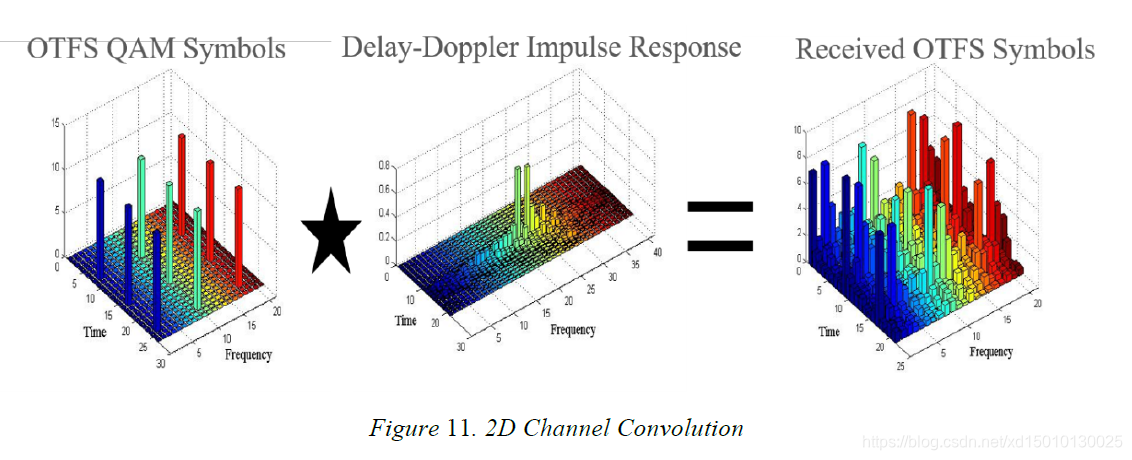content
前言:和前面的类似,这部分依旧比较偏概念性的描述而缺少实际的公式和例子说明,是对延迟-多普勒信道符号耦合特性的描述
1.Definition定义
The wireless channel is governed by simple physics. It is composed of a collection of specular reflectors, some of which are static and some of which are moving. The transmitted waveform propagates through the medium and bounces off each reflector. The signal that arrives at the receiver is a superposition of the direct signal and the reflected echoes. Each of the reflected echoes arrives at the receiver at a delayed time (multipath effect) and possibly also shifted in frequency (Doppler effect) due to the relative velocity between the reflector and the transmitter/receiver. The channel physics is mathematically modeled through the delay-Doppler impulse response where each tap represents a cluster of reflectors with specific delay and Doppler characteristics, as shown in Figure 4. Our goal in this section is to describe the channel-symbol coupling (CSC for short) between the wireless channel and the OTFS carrier waveform given by a localized pulse in the delay-Doppler representation. As a motivation, we first discuss the channelsymbol coupling of the TDM and FDM pulses.
这个定义揭示的是信道和传输符号耦合的实质。即符号经过由多径产生的时延以及多普勒产生的频移的各个符号的叠加。

2.Example例子
2.1Channel symbol coupling of the TDM pulses
Transmitting a localized TDM pulse in the time representation gives rise at the receiver to a configuration of echoes which appear at specific time displacements which corresponds to the multipath delays imposed by the various reflectors. The phase and amplitude of
each echo depend on the initial position of the transmitted pulse and might change significantly among different coherence time intervals – a phenomenon referred to as time selectivity. There are two mechanisms involved. The phase of the echo changes due to the Doppler effect and the amplitude of the echo changes due to destructive superposition of numerous reflectors sharing the same delay but differing in Doppler, resulting from the inability of the TDM pulse to separate reflectors along Doppler. In Figure 9, counting the TDM echoes from left to right we see that the first and third echoes are due to static reflectors hence are time invariant, the fourth echo is due to moving reflector thus is time varying and the second echo is due to superposition of two reflectors, one of which is moving thus is fading.
解释一下这段话的含义:
- 每个回波的相位和振幅取决于发射脉冲的初始位置,并可能在不同的相干时间间隔之间发生显著变化,这种现象称为时间选择性。
- 回波的相位由于多普勒效应而改变,而回波的振幅由于具有相同延迟但不同多普勒的多个反射器的破坏性叠加而改变,这是由于TDM脉冲无法沿多普勒分离反射器造成的
- 说明一下例子:
从时间维度来看- 一和三是静态的反射器且只有一个,所以是时不变的
- 四因为车在移动所以是时变的
- 二是两个的叠加,一个动一个不动,所以是衰落
2.2Channel symbol coupling of the FDM pulses
Reciprocally, transmitting a localized FDM pulse in the frequency representation gives rise at the receiver to a configuration of echoes at specific frequency displacements which correspond to the Doppler shifts induced by the various reflectors. The phase and amplitude of each echo depends on the initial position of the transmitted pulse and might change significantly among different coherence frequency intervals – a phenomenon referred to as frequency selectivity. The phase of the echo changes due to the multipath effect and the amplitude of the echo changes due to destructive superposition of numerous reflectors sharing the same Doppler but perhaps differing in delay, resulting from the inability of the FDM pulse to separate reflectors along delay. For example, in Figure 9, counting the received FDM echoes from bottom up, we see that the first and third echoes are frequency varying and the second echo is due to superposition of three static reflectors thus is fading.
回波的相位由于多径效应而改变,而回波的振幅由于共享同一多普勒但可能不同延迟的多个反射器的破坏性叠加而改变,也就是说从频域来看,如果多普勒频移一致,但是时延不同的话,就会导致不同的回波相位不同,可能就会导致叠加在一起的相位呈现出不同的特性。

2.3Channel symbol coupling of the OTFS pulses
Transmitting a localized OTFS pulse in the delay-Doppler representation gives rise at the receiver to a configuration of echoes that appear at specific delay-Doppler displacements, which corresponds to the delay and Doppler shifts induced by the various reflectors, as shown in Figure 10. In contrast to the previous two cases, the following properties now hold:
- CSC invariance: the phase and amplitude of the delay-Doppler echoes are independent of the location of the original pulse inside the fundamental domain, since the delay and Doppler periods are smaller than the coherence time and bandwidth of the channel respectively
- CSC separability: all the reflections are separated from one another along their delay and Doppler characteristics, hence their effects do not add up destructively and there is no loss of energy on the QAM symbol level.
- CSC orthogonality: the received echoes are confined to a small rectangular box around the transmitted pulse with dimensions equal the delay and Doppler spread of the channel which are much smaller than the outer delay and Doppler periods.??? As result, when two transmit pulses are geometrically separated at the transmitter they will remain orthogonal at the receiver.
An alternate way to express the OTFS channel-symbol coupling is as a two dimensional convolution between the delay-Doppler impulse response and the QAM symbols. This can be seen in Figure 11, which shows numerous delta functions (representing QAM symbols) convolved with the delay-Doppler impulse response of the channel.
这段话的意思是因为具有时移和多普勒两个维度的分辨能力,所以我们的OTFS脉冲具有了不变性,可分离性,正交性.但是为什么具有这个能力也没有具体论述

























 4万+
4万+











 被折叠的 条评论
为什么被折叠?
被折叠的 条评论
为什么被折叠?








